Skateboard decks: types, sizes, shapes, tips for choosing
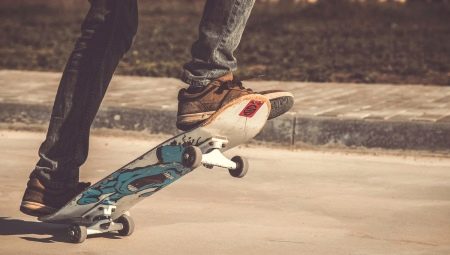
The deck is the most important element of the skateboard design, it largely determines the convenience and safety of its operation. Therefore, the choice of the board must be approached very seriously and responsibly.

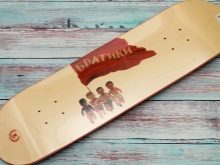
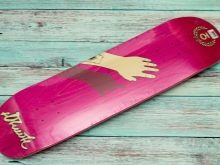
Specifications
A deck is called a skateboard platform, on which tracks with wheels are fixed from below, and a skateboarder is placed on top. Various materials are used to make the board, but the best of them is the Canadian maple. This is due to the fact that trees growing near the Great Lakes of North America give very dense and at the same time resilient wood.
It is the ability to spring that makes the Canadian maple the most suitable material for making decks, distinguishing it favorably from other tree species. In addition, it is very easy to handle and can withstand high mechanical loads. In addition to Canadian maple, Chinese maple and birch are also used in the production of skateboard decks. In terms of their operational characteristics, they are significantly inferior to their overseas competitor, but they are much cheaper and are quite suitable for beginners.
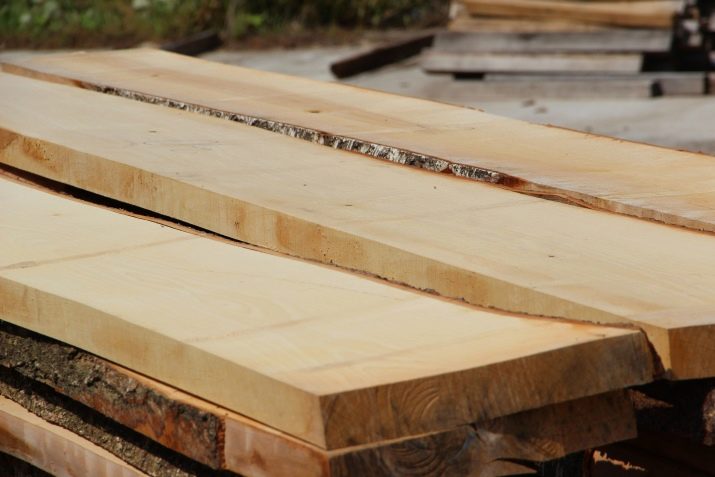
Wooden decks have a multi-layer structure consisting of 6, 7, or even 9 layers. Upon closer examination of the end of the board, you can see their exact number and the order of arrangement, in which some layers have a longitudinal direction, while others have a transverse direction. Thanks to this design, the deck gains additional elasticity and becomes especially durable.
The layers are glued together with a special glue and pressed under high pressure. The higher the quality of the glue, the longer the board will not delaminate. The elasticity of the soundboard also depends on the number of layers, which directly affects the height of the jump. The more there are, the more springy the "click" is - pushing the edge of the board off the ground, and the higher it is possible to "raise" the skate.
Some models have an additional bottom layer called slick... It is made of plastic and serves to perform tricks on handrails, making it easier to slide on metal rungs.
Such boards weigh more than usual and are not very comfortable for beginners. By the way, experienced skateboarders also do not particularly like them, claiming that decks without a plastic bottom slide along the railing no worse than slicks.

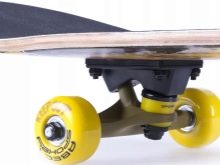
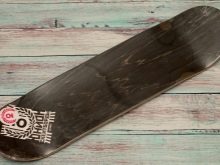
On the upper side of the wooden decks there is a special skin called flu. She represents plain sandpaper with a self-adhesive backing and is designed to prevent skateboarder feet from sliding over the surface of the board. Outwardly, grips are black without a pattern or color with photo printing, and in terms of execution - solid or perforated.
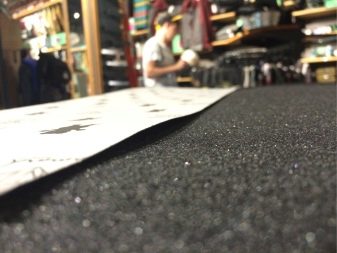
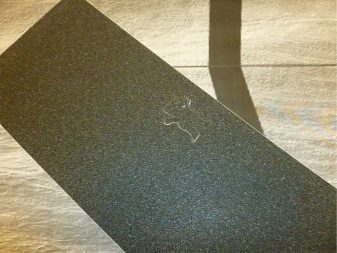
Sandpaper with holes is more preferable for self-gluing: they lie flat on the deck and do not form air bubbles. With regular skating, the skin wears off rather quickly, so from time to time it will have to be changed. When choosing a new flute, you need to take into account that fine-grained abrasive wears off faster, and coarse-grained one gets clogged with dirt from the soles and stops clinging. Therefore, the best option would be to choose a medium-grain black or gray skin.
In addition to wood, they use Impact resistant plastic that can withstand high weight and shock loads.
Plastic platforms have found their use on penny boards - a miniature type of skateboards designed for everyday movement over short distances and performing simple jumps. Plastic decks, as a rule, do not have flu-tapes, and their function is taken over by the relief pattern of the deck, which does not allow the rider's feet to slide on the board.

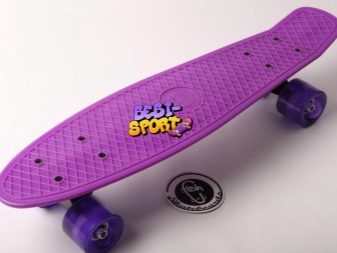
Dimensions and shape
Modern decks differ in length, width and bend depth, and the listed parameters are always strictly proportional to each other and are indicated in inches. When choosing the right size must take into account the height of the rider.
So, for a preschool child with a height of 100 cm, a children's model with dimensions of 27.2x6.5 inches (69x16.5 cm) is suitable, for elementary school students - a board measuring 28x7 inches and for older children - 29x7.3 inches.
When it comes to the size of the adult boards, they range in width from 7.5 to 8.2 inches (19-21 cm) with a length of about 31.5 inches, which is 80 cm.



When choosing the size of the board, you need to take into account that wide decks are more comfortable for landing after tricks, as well as for ramps and long-distance journeys. But the narrow ones are more maneuverable and better suited for twisting complex flips, the execution of which requires special accuracy and speed.
As for the shape of the deck, then it varies depending on the purpose and narrow specialization of the skateboard... For example, all classic models are rounded at the front and back ends, called nose and tail, respectively. The sides of the boards have a bend, which is called a concave, and is necessary to perform flips. The depth of the concave is different for all boards and depends on the size and purpose of the board.
So, on stunt models designed for difficult jumps and extreme riding, the deck has a large bending amplitude. Shallow concave decks are designed for quiet riding on flat roads and are not suitable for flips.
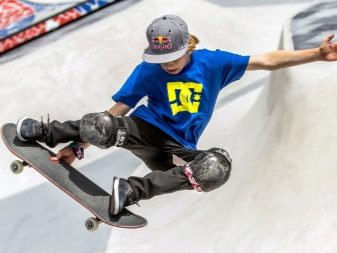
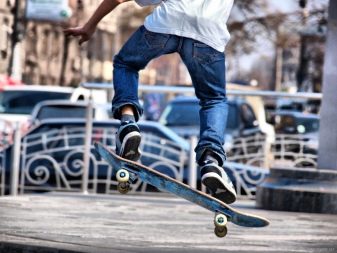
How to choose?
There are a number of important things to consider when buying a skateboard deck.
- First of all, make sure that the board is not twisted., since it will be impossible to fix such a defect, and if a defect is found after installing the tracks, then such a product will not be taken back either.The twisting of the deck is the result of improper storage and transportation, during which the integrity of the sealed factory packaging was broken. Therefore, the first thing to do when buying a board is to check if the original package of the deck is torn.
- This should be followed by a visual assessment of the surface of the board, for which it is taken by the tail and nose and placed at eye level with the bottom up. If the front and rear are in the same plane, then the deck was not subject to deformation. If the parts are at different heights, this is evidence that the board was led and there is no need to buy such a product. Wood distortions can occur not only due to improper storage, but also due to the use of low-quality glue in the manufacture of boards.
- Make sure the deck is free of nicks, chips, bumps and check the quality of the grip... It should have a uniform, medium-grained texture, without bubbling or bald spots.
- It is advisable to pay attention and for the period of making the deck, since boards that have been on the counter for a long time dry out and break very quickly.
- And the last thing to look at when buying a deck is company manufacturer. Professional skateboarders recommend purchasing products from foreign companies Baker, Flip, Zero, Alien Workshop, Zoo York, BirdHouse, Toy Machine, Plan B, Powell and Foundation. From Russian brands you can choose "Absurd", "Union" and Footwork. Domestic models cost almost 2 times cheaper, and in terms of quality they are not much inferior to samples of foreign production.
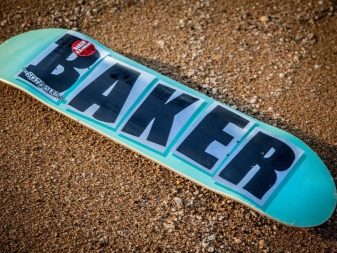

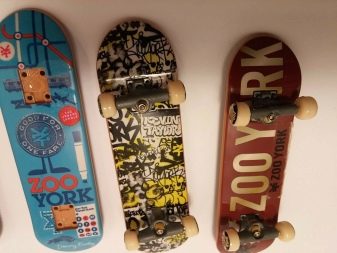
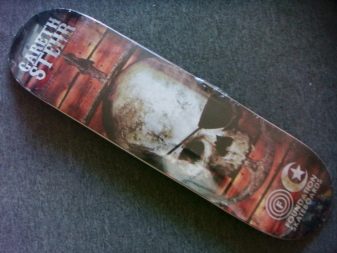
Storage conditions and care
In order for the deck to last as long as possible, it must be regularly cleaned from dirt using a soft, damp cloth... Then the board is wiped dry and stored. Skateboards with wooden decks should be stored in rooms with an air humidity of no higher than 85% and a temperature of 5 to 25 degrees Celsius. Such external conditions are considered optimal for glued wood and ensure that the product retains all its operational properties. There is no humidity limit for plastic decks, the main thing is that the air temperature does not fall below zero.

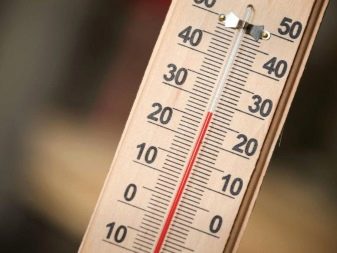
For information on how to choose a skateboard deck, see the next video.








